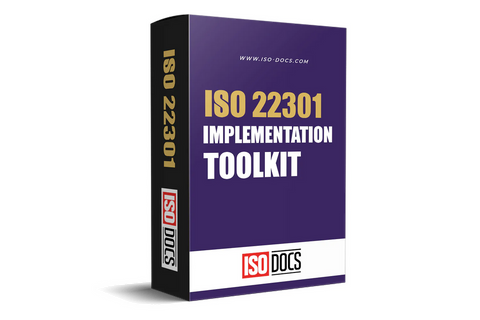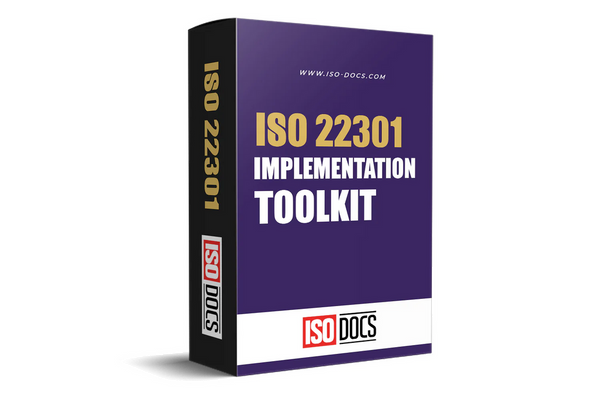ISO 22301: Record Control Plan
In the realm of business continuity management, adherence to international standards is paramount for ensuring resilience and preparedness. ISO 22301, the globally recognized standard for business continuity, places a significant emphasis on the effective management of information, particularly in the context of records. The ISO 22301 Record Control Plan serves as a pivotal document within the framework, delineating the systematic approach an organization undertakes to create, manage, and safeguard critical records.

This plan is strategically designed to align with the ISO 22301 requirements, offering a structured methodology for controlling records throughout their lifecycle. As organizations navigate the complexities of modern business environments, a robust Record Control Plan becomes indispensable, providing a roadmap to maintain the integrity, availability, and confidentiality of essential information.
Importance for ISO 22301:Record Control Plan
Regulatory Compliance:
- Ensures adherence to ISO 22301 standards, demonstrating a commitment to robust business continuity practices.
- Mitigates legal and regulatory risks associated with inadequate record management.
Risk Mitigation:
- Identifies and addresses potential risks related to information mismanagement, preventing data breaches or loss of critical records.
- Establishes controls to minimize the impact of disruptions on record availability.
Documentation Integrity:
- Safeguards the integrity of business-critical documents by outlining procedures for creation, modification, and disposal.
- Ensures accuracy and reliability of information, fostering trust among stakeholders.
Operational Resilience:
- Strengthens an organization's ability to function seamlessly during and after disruptive events by ensuring access to vital records.
- Facilitates swift recovery and minimizes downtime through effective record retrieval.
Efficient Information Retrieval:
- Streamlines access to essential records, reducing response times during emergencies or audits.
- Enhances overall efficiency in decision-making processes by providing timely access to accurate data.
Continuous Improvement:
- Encourages a culture of continuous improvement through regular reviews and updates to the Record Control Plan.
- Facilitates adaptation to evolving business needs and changes in regulatory requirements.
Stakeholder Confidence:
- Builds trust among stakeholders, including customers, partners, and regulatory bodies, by showcasing a commitment to information security and resilience.
- Enhances the organization's reputation for reliability and professionalism.
Resource Optimization:
- Optimizes resource allocation by defining clear guidelines for the allocation of resources related to record management.
- Prevents unnecessary duplication of efforts and ensures cost-effective practices.
Audit Preparedness:
- Prepares the organization for audits by establishing a systematic approach to record control.
- Demonstrates accountability and transparency in record-keeping practices.
Alignment with Business Objectives:
- Aligns record management practices with broader business objectives, ensuring that information assets contribute to organizational goals.
- Enhances strategic decision-making through the availability of accurate and well-managed records.
Key components for ISO 22301:Record Control Plan
Scope and Objectives:
- Clearly define the scope of the Record Control Plan, outlining the types of records it covers.
- Specify the overarching objectives, such as ensuring data integrity, availability, and compliance with ISO 22301 standards.
Record Identification and Classification:
- Establish a systematic process for identifying and classifying records based on their importance and sensitivity.
- Define criteria for categorizing records to facilitate efficient management and retrieval.
Record Creation and Capture:
- Outline procedures for the creation, capture, and entry of records into the organization's systems.
- Specify metadata requirements to accompany records for proper identification and context.
Access Controls and Permissions:
- Define access controls to restrict unauthorized access to sensitive records.
- Clearly delineate roles and responsibilities regarding who can access, modify, and approve records.
Retention and Disposal Policies:
- Develop policies for the retention and timely disposal of records, aligning with legal, regulatory, and business requirements.
- Specify procedures for the secure destruction or archiving of records as per their lifecycle.
Version Control and Change Management:
- Implement version control mechanisms to track changes made to records over time.
- Establish a change management process to document and authorize modifications to record management procedures.
Audit Trails and Monitoring:
- Incorporate audit trails to log activities related to record management, aiding in accountability and traceability.
- Implement monitoring mechanisms to detect and respond to unusual or unauthorized access or changes to records.
Backup and Recovery Procedures:
- Define robust backup procedures to ensure the availability of records in the event of data loss or system failures.
- Establish recovery procedures to restore records quickly and minimize downtime.
Training and Awareness Programs:
- Develop training programs to ensure that employees understand the Record Control Plan and their roles in its implementation.
- Foster awareness of the importance of proper record management and compliance with ISO 22301 standards.
Documentation and Reporting:
- Create templates and formats for documenting key aspects of record management processes.
- Establish reporting mechanisms to provide regular updates on the status of record management activities and compliance.
Continuous Improvement Mechanisms:
- Implement mechanisms for regular reviews and audits to identify areas for improvement.
- Establish a feedback loop to incorporate lessons learned and enhance the effectiveness of the Record Control Plan.
Integration with Business Processes:
- Ensure seamless integration of record management processes with broader business processes.
- Align the Record Control Plan with the organization's overall business continuity and risk management strategies.

The Benefits for ISO 22301:Record Control Plan
Compliance Assurance:
- Ensures adherence to ISO 22301 standards.
- The Record Control Plan serves as a tool for aligning record management practices with the requirements set forth by ISO 22301, offering a structured approach to compliance and demonstrating commitment to international standards.
Risk Reduction:
- Mitigates the risk of data breaches and information loss.
- By implementing controls and procedures for record management, the plan reduces the risk of unauthorized access, data manipulation, or loss, contributing to the overall resilience of the organization.
Efficient Decision-Making:
- Facilitates timely and informed decision-making.
- A well-organized Record Control Plan ensures that essential records are readily accessible, enabling decision-makers to access accurate information promptly during normal operations or crisis situations.
Operational Continuity:
- Strengthens operational continuity during disruptions.
- The plan ensures that critical records necessary for ongoing operations are available, even in the face of disruptions or disasters, minimizing downtime and supporting business continuity.
Enhanced Data Integrity:
- Safeguards the integrity of organizational records.
- Through clear guidelines for record creation, modification, and disposal, the plan helps maintain the accuracy and reliability of data, fostering trust in the information used for decision-making.
Improved Audit Preparedness:
- Prepares the organization for audits and assessments.
- The plan establishes a systematic approach to record management, making it easier for the organization to demonstrate compliance during audits and assessments, reducing the risk of non-compliance findings.
Resource Optimization:
- Optimizes resource allocation related to record management.
- By defining efficient processes and controls, the plan prevents duplication of efforts and ensures that resources are allocated effectively, contributing to cost-effectiveness.
Stakeholder Confidence:
- Builds trust among stakeholders.
- Stakeholders, including customers, partners, and regulatory bodies, gain confidence in the organization's ability to manage information securely and maintain operational resilience, positively impacting the overall reputation.
Continuous Improvement Culture:
- Fosters a culture of continuous improvement.
- Regular reviews and updates to the Record Control Plan encourage the organization to adapt to evolving needs, emerging risks, and changes in regulatory requirements, fostering a culture of continuous improvement.
Legal and Regulatory Compliance:
- Addresses legal and regulatory requirements.
- The plan includes measures to ensure that record management practices align with legal and regulatory frameworks, reducing the organization's exposure to legal risks and penalties.
Efficient Information Retrieval:
- Streamlines access to essential records.
- Well-defined procedures in the Record Control Plan contribute to efficient information retrieval, reducing the time and effort required to access critical records when needed.
Alignment with Business Goals:
- Aligns record management with broader business objectives.
- The plan ensures that record management practices support organizational goals, contributing to strategic decision-making and the overall success of the business.
Conclusion
In conclusion, the implementation of an ISO 22301 Record Control Plan stands as a pivotal step towards ensuring the resilience, security, and efficiency of an organization's information management processes. By meticulously addressing key components such as regulatory compliance, risk mitigation, and efficient decision-making, this plan becomes a cornerstone for operational continuity, even in the face of disruptions.
The benefits extend beyond mere compliance, encompassing improved data integrity, optimized resource allocation, and heightened stakeholder confidence. As an instrument for fostering a culture of continuous improvement, the Record Control Plan not only aligns record management practices with international standards but also positions the organization to adapt and thrive in dynamic business landscapes. In essence, it serves as a proactive safeguard, fortifying the organization's ability to navigate uncertainties while maintaining the integrity and availability of critical records.



